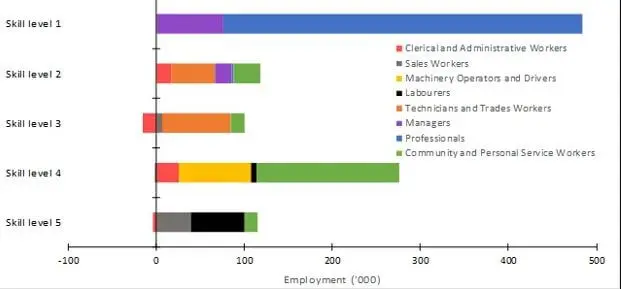High Demand Jobs in Australia for Foreigners 2024

Out of the more than two hundred professions listed on the Skilled Migration list, we have selected the fifty most in-demand jobs in Australia by the recently revised occupation ceilings by the government. This read will educate you on how you can leverage this to your benefit and migrate to Australia as a skilled professional.
The following sectors have been listed by the Australian labor market that are going to be in high demand:
- Health Care and Social Assistance (252,600 jobs by 2024)
- Professional, Scientific, and Technical Services (172,400 jobs by 2024)
- Education and Training (113,700 jobs by 2024)
- Construction (118,800 jobs by 2024)
Check Also: Fruit Picking Jobs in Australia with Visa Sponsorship
What are Occupation Ceilings?
- The quantity of Expressions of Interest (EOI) or invitations issued by the Australian Government for a particular occupation group is constrained by an Occupation Ceiling.
- This ensures consistency across the various professions accessible to proficient individuals.
- No further invitations will be extended to the occupation group that has surpassed the limit until the following year.
- State or Territory Nominated Occupation, employer-sponsored, and Business Innovation and Investment visa subclasses are exempt from ceilings.
Benefits of High Demand Jobs in Australia for Foreigners
- Securing Employment Stability: Job opportunities that are in high demand frequently offer greater stability, thereby mitigating the likelihood of unemployment and providing enhanced job security.
- Comparative Wages: Professions that are in high demand frequently offer competitive salaries or compensation, thereby increasing the earning potential of their practitioners.
- Recognizing the Skills Shortage: Many in-demand occupations are located in sectors that are currently facing shortages of skilled labor. Employers may provide supplementary benefits or incentives to retain and attract qualified professionals.
- Possibilities for Progression: There are frequent opportunities for career advancement, talent development, and progress within the field in industries that are in high demand.
- Occupational Benefits: Numerous positions that are in high demand provide enticing benefit packages, such as medical insurance, retirement plans, bonuses, and extra rewards.
- The Potential for Global Opportunities: Professions that are in high demand, particularly those in the STEM sectors and healthcare, provide prospects for international work experience and global mobility.
- Diversity in Industry: Consisting of occupations in construction, education, healthcare, information technology, engineering, professions, and education, high-demand positions provide opportunities for those with a variety of interests and skill sets.
- Government Assistance: The Australian government frequently provides financial assistance, training initiatives, and incentives to professionals who enter high-demand sectors to promote skill development.
- Life-Work Balance:
- Specific positions that are in high demand, especially within sectors such as healthcare, prioritize employee well-being over work-life balance and provide flexible work arrangements.
- Implications for the Economy: Prominent occupations make substantial contributions to the economy of a nation through their ability to stimulate innovation, fulfill critical requirements, and maintain expansion in pivotal sectors.
Australia’s Top 50 Jobs in Demand
| Rank | Jobs in demand | Occupation ID | Occupation Ceiling 2022–23 |
| 1 | Registered Nurses | 2544 | 17,859 |
| 2 | Secondary school teachers | 2414 | 8,716 |
| 3 | Software and Applications Programmers | 2613 | 8,405 |
| 4 | Electricians | 3411 | 8,021 |
| 5 | Construction Managers | 1331 | 7,145 |
| 6 | Carpenters and joiners | 3312 | 6,812 |
| 7 | Metal fitters and machinists | 3232 | 6,335 |
| 8 | Plumbers | 3341 | 5,861 |
| 9 | Motor Mechanics | 3212 | 5,205 |
| 10 | University Lecturers and Tutors | 2421 | 5,042 |
| 11 | Structural Steel and Welding Trades Workers | 3223 | 4,866 |
| 12 | Solicitors | 2713 | 4,535 |
| 13 | Management consultants | 2247 | 4,526 |
| 14 | General practitioners and resident medical officers | 2531 | 4,257 |
| 15 | Other specialist managers | 1399 | 4,188 |
| 16 | Civil Engineering Professionals | 2332 | 3,919 |
| 17 | Early Childhood (Pre-Primary School) Teachers | 2411 | 3,321 |
| 18 | Painting Trades Workers | 3322 | 3,303 |
| 19 | Industrial, mechanical, and production engineers | 2335 | 2,682 |
| 20 | Database and Systems Administrators and ICT Security Specialists | 2621 | 2,667 |
| 21 | ICT Business and Systems Analysts | 2611 | 2,273 |
| 22 | Chefs | 3513 | 2,256 |
| 23 | Computer Network Professionals | 2631 | 2,245 |
| 24 | Electronics Trades Workers | 3423 | 2,047 |
| 25 | Social Workers | 2725 | 1,862 |
| 26 | Special Education Teachers | 2415 | 1,721 |
| 27 | Bricklayers and stonemasons | 3311 | 1,712 |
| 28 | Cabinetmakers | 3941 | 1,694 |
| 29 | Physiotherapists | 2525 | 1,685 |
| 30 | Health and Welfare Services Managers | 1342 | 1,666 |
| 31 | Auditors, company secretaries, and corporate treasurers | 2212 | 1,619 |
| 32 | Air conditioning and refrigeration mechanics | 3421 | 1,581 |
| 33 | Psychologists | 2723 | 1,545 |
| 34 | Medical Laboratory Scientists | 2346 | 1,536 |
| 35 | Engineering Managers | 1332 | 1,474 |
| 36 | Occupational Therapists | 2524 | 1,461 |
| 37 | Architects and Landscape Architects | 2321 | 1,452 |
| 38 | Plasterers | 3332 | 1,452 |
| 39 | Electrical Engineers | 2333 | 1,348 |
| 40 | Midwives | 2541 | 1,333 |
| 41 | Environmental Scientists | 2343 | 1,295 |
| 42 | Sports coaches, instructors, and officials | 4523 | 1,262 |
| 43 | Animal attendants and trainers | 3611 | 1,239 |
| 44 | Other medical practitioners | 2539 | 1,168 |
| 45 | Medical Imaging Professionals | 2512 | 1,161 |
| 46 | Other Natural and Physical Science Professionals | 2349 | 1,056 |
| 47 | Accountants | 2211 | 1,000 |
| 48 | Wall and floor tilers | 3334 | 1,000 |
| 49 | Artistic Directors, Media Producers, and Presenters | 2121 | 1,000 |
| 50 | Actors, Dancers, and Other Entertainers | 2111 | 1,000 |
The Australian Skilled Migration Program provides the most advantageous work visa pathway for individuals seeking employment in the nation.
Covid-19 Impact Opens News Doors for Skilled Migrant Workers
To assist Australia’s economy in recovering from the effects of COVID-19, the government has designated seventeen occupations to meet the critical skills needs list. Employer-sponsored nominations and visa applications that include an occupation on the PMSOL will be given priority processing. A temporary travel exemption will be granted to visa holders.
Priority Migration Skilled Occupation List (PMSOL)
The 17 occupations (ANZSCO code) are:
- Chief Executive or Managing Director (111111)
- Construction Project Manager (133111)
- Mechanical Engineer (233512)
- General Practitioner (253111)
- Resident Medical Officer (253112)
- Psychiatrist (253411)
- Medical Practitioner nec (253999)
- Midwife (254111)
- Registered Nurse (Aged Care) (254412)
- Registered Nurse (Critical Care and Emergency) (254415)
- Registered Nurse (Medical) (254418)
- Registered Nurse (Mental Health) (254422)
- Registered Nurse (Perioperative) (254423)
- Registered Nurses nec (254499)
- Developer Programmer (261312)
- Software Engineer (261313)
- Maintenance Planner (312911)
Priority processing on PMSOL applies to these employer-sponsored visa subclasses:
- Temporary Skill Shortage (TSS) Visa (subclass 482)
- Skilled Employer Sponsored Regional (Provisional) Visa (Subclass 494)
- Employer Nomination Scheme (ENS) visa (subclass 186)
- Regional Sponsored Migration Scheme (RSMS) visa (subclass 187)
Other occupations on skilled migration list
| Job Category | Occupation ID | Occupation Ceiling 2022–23 |
| Actuaries, mathematicians, and statisticians | 2241 | 1,000 |
| Agricultural and Forestry Scientists | 2341 | 1,000 |
| Automotive Electricians | 3211 | 1,000 |
| Barristers | 2711 | 1,000 |
| Boat builders and shipwrights | 3991 | 1,000 |
| Cartographers and surveyors | 2322 | 1,000 |
| Chemical and Materials Engineers | 2331 | 1,000 |
| Chemists and Food and Wine Scientists | 2342 | 1,000 |
| Child Care Center Managers | 1341 | 1,000 |
| Chiropractors and osteopaths | 2521 | 1,000 |
| Civil Engineering Draftspersons and Technicians | 3122 | 1,000 |
| Economists | 2243 | 1,000 |
| Electrical Distribution Trades Workers | 3422 | 1,000 |
| Electrical Engineering Draftspersons and Technicians | 3123 | 1,000 |
| Electronics Engineers | 2334 | 1,000 |
| Geologists, geophysicists, and hydrogeologists | 2344 | 1,000 |
| Glaziers | 3331 | 1,000 |
| Internal medicine specialists | 2533 | 1,000 |
| Land Economists and Values | 2245 | 1,000 |
| Life Scientists | 2345 | 1,000 |
| Mining Engineers | 2336 | 1,000 |
| Multimedia Specialists and Web Developers | 2612 | 1,000 |
| Music Professionals | 2112 | 1,000 |
| Optometrists and orthoptists | 2514 | 1,000 |
| Other engineering professionals | 2339 | 1,000 |
| Other Health Diagnostic and Promotion Professionals | 2519 | 1,000 |
| Panel beaters | 3241 | 1,000 |
| Podiatrists | 2526 | 1,000 |
| Precision Metal Trades Workers | 3233 | 1,000 |
| Psychiatrists | 2534 | 1,000 |
| Sheetmetal Trades Workers | 3222 | 1,000 |
| Speech professionals and audiologists | 2527 | 1,000 |
| Sportspersons | 4524 | 1,000 |
| Surgeons | 2535 | 1,000 |
| Telecommunications Engineering Professionals | 2633 | 1,000 |
| Telecommunications Technical Specialists | 3132 | 1,000 |
| Veterinarians | 2347 | 1,000 |
Different Programs for Skilled Australian Immigration
- Skilled Nominated Visa (Subclass 190)
Those who have received a job offer before applying for the Skilled Nominated program may do so. You should seek employment in Australia.
- Skilled Independent Visa (Subclass 189)
Australia is an immigration country for qualified independents. There is no requirement for employer, state, or family sponsorship.
Eligibility Requirements for High Demand Jobs in Australia
You need to score more than 65 points out of 100.
Points are allotted based on:
- Age: You need to be 18 to 45 years old to apply for this program.
- Education: The authorities prefer you if you have a bachelor’s degree, a master’s degree, or a Ph.D.
- Work experience: You should have at least one year of experience in your occupation.
- Linguistic abilities: You need to prove your English language proficiency.
- Health Certificate
- Good conduct certificate
How to Apply for High Demand Jobs in Australia

Step 1: Accreditation
- An accrediting body assesses you by Australian standards by considering your occupation type, educational qualifications, and work experience.
- You are issued a letter of accreditation upon approval. Different accrediting bodies govern distinct professions. The decision may be relayed to you within two to three months.
Step 2: English Language Test
- An IELTS score of at least 6 out of 9 is required for each of the four language skills: speaking, reading, writing, and listening.
Step 3: EOI and ITA
- You must submit your Expression of Interest (EOI) for the visa through Skill Select.
- You must receive an invitation from the Australian government to register for the skilled visa. To accomplish this, proceed to submit an Expression of Interest via the Skill Select menu.
Step 4: State Nomination Application
- One may seek state government nomination if their profession is deemed highly desirable in a specific jurisdiction. The results of your nomination may be available one to four weeks after the submission of your application.
Step 5: Online Visa Application
- In addition to certified translations of your professional and work experience documents, your registration must also include certified copies of other formal documents.
Step 6: Medical Exams and Police Certificates
- After receiving a medical examination from an Australian Embassy-registered local practitioner, and only then
- Additionally, a police certificate clearance attesting to a minimum of twelve months of residency in the nation within the previous ten years will be required.
Costs Involved
| Fees Category | Fees in AUD |
| Primary Applicant | 4,115 |
| Dependents below 18 years | 2,055 |
| Dependent below 18 years | 1,030 |
| State Sponsorship (if applicable) | 298.44 |
| Medical test fees | 29.57 to 98.55 |
| Visa label fees | 69.68 |
What is Australia PR Visa Processing Time?
It requires between nine and twelve months to complete the procedure.
Projections for employment growth through 2024:

- Skill level 1 occupations with a bachelor’s degree or higher qualification (up by 484,600 or 11.8 percent)
- Skill level 2 occupations with Advanced Diploma or Diploma (83,400 or 8.1 percent)
- Skill level 4 occupations with Certificate I or secondary education (276,000 or 8.1 percent)
- Over 5 million jobs are created through this turnover each year.
Conclusion
The Australian Bureau of Statistics (ABS) divides occupations into five distinct skill levels. An equivalent level of education or formal work experience in the respective discipline is associated with each skill level.
For More Info:
Email Your CV, and We’ll Find the Best Pathway For you: info@friendsmart.com.pk
Frequently Asked Questions:
-
What jobs are in high demand right now in Australia?
The demand for white-collar jobs like actuaries, tax accountants, and solicitors is soaring. With 36% of all occupations experiencing worker shortages, the trend is clear: Australia needs skilled professionals.
-
What is a good salary in Australia?
Since the average weekly ordinary earnings for Australians will be $1,838.10, anything around this figure would be considered a good salary. However, it is worth keeping in mind that different people have different financial needs and therefore have different ideas of what a “good” salary is for them.
-
Can I get a job directly in Australia?
Getting a job in Australia is easy if you explore visa options such as skilled migration visas, employer-sponsored visas, or working holiday visas, depending on your circumstances. These visas contain specific eligibility requirements, so make sure to fulfill these requirements and then try to get a job.



